KVPY SA Exam: Analysis Of Exam Pattern, Previous Years’ Question Papers
Around 50,000 students appear for Kishore Vaigyanik Protsahan Yojana - SA (KVPY-SA) every year of whom only 1,100 are selected for scholarships. As KVPY-SA is coming up soon, Class 11 students will be preparing for this exam and schools will work on getting them ready. Students of Class 11 can find all the important information related to KVPY-SA in this article.
This Story also Contains
- KVPY Exam, Eligibility Criteria
- KVPY Scholarship Courses
- KVPY Exam Pattern
- KVPY Syllabus
- KVPY Previous Years’ Question Papers
- KVPY SA Syllabus: Class-Wise Weightage
- KVPY SA Syllabus: Subject-Wise Analysis
- KVPY Exam: How To Make It

NOTE- DST has decided to subsume KVPY with INSPIRE. KVPY Aptitude test will not be conducted from the year 2022 onwards. Ongoing KVPY fellows will continue to receive fellowship as per norms from DST.
Given below is a detailed analysis of the exam and the syllabus. While there’s no officially-defined KVPY syllabus, the exam asks questions from course content covered in Classes 9 to 12. The analysis of the KVPY exam pattern and comparison of the weightage assigned to syllabus of different classes will help students strategise and prepare for the KVPY-SA well in time.
KVPY Exam, Eligibility Criteria
The Kishore Vaigyanik Protsahan Yojana (KVPY full form) is a national-level fellowship programme in basic sciences conducted by the Indian Institute of Science, Bengaluru. KVPY is written by students who are interested in science and research and want to pursue a career in this field. It is a computer-based test containing three streams — SA , SB, and SX. KVPY- SA is for students of Class 11; SB is for Class 12 students, and SX is for students in undergraduate (UG) courses in the basic sciences.
This fellowship programme was initiated and is funded by the Department of Science and Technology, Government of India, to attract exceptional students to pursue careers in science. Students eligible for KVPY can get scholarships up to pre-PhD level as well as admission into institutes like the IISc and the Indian Institutes of Science Education and Research (IISERs), through their additional criteria. The main aim of this programme is to test the understanding and analytical ability of the student.
Also Read,
KVPY Scholarship Courses
Students selected under this stream will receive their fellowships after joining an undergraduate course in basic sciences after passing Class 12. They can be enrolled in these programmes — BSc, BS, BStat, BMath, Integrated MSc or MS.
KVPY Exam Pattern
The KVPY-SA is an online exam. The KVPY question paper contains a total of 80 questions divided into two sections, Part 1 and Part 2. Part 1 contains 60 questions and part 2 consists of 20 questions. Part 1 and Part 2 are further divided into four sections each: Physics, Mathematics, Chemistry, and Biology. Questions in Part 1 carry one mark each and those in Part 2 carry two marks each. For every wrong answer, in part 1, 0.25 marks and in part 2, 0.5 marks are docked from the total. Both parts of the KVPY question paper contain multiple-choice questions (MCQ) and are in both Hindi and English. All questions are compulsory to attempt. The paper carries a total of 100 marks and the exam itself is of 3 hours duration.
KVPY Syllabus
Although, officially there’s no chapter-wise syllabus, Careers360 analysed previous years’ question papers and found that the KVPY SA syllabus draws from course content taught in Classes 9, 10 and 11 and parts of Class 12 as well. Broadly, the syllabus covers Physics, Chemistry, Biology, and Mathematics. Questions asked in the exam are basically from textbooks by the National Council for Educational Research and Training (NCERT) for various Classes.
KVPY Previous Years’ Question Papers
A detailed analysis of the previous five years’ question papers can yield crucial insights into the class-wise weightage of syllabus and important chapters. Such insights will help students formulate their preparation strategy.
KVPY SA Syllabus: Class-Wise Weightage
A total of 460 questions were analysed from the past five years. The analysis showed that the maximum questions were from Class 11, followed by Class 10 and that the weightage assigned to the Class 12 syllabus was also appreciable. Given below is the distribution of questions across Classes.
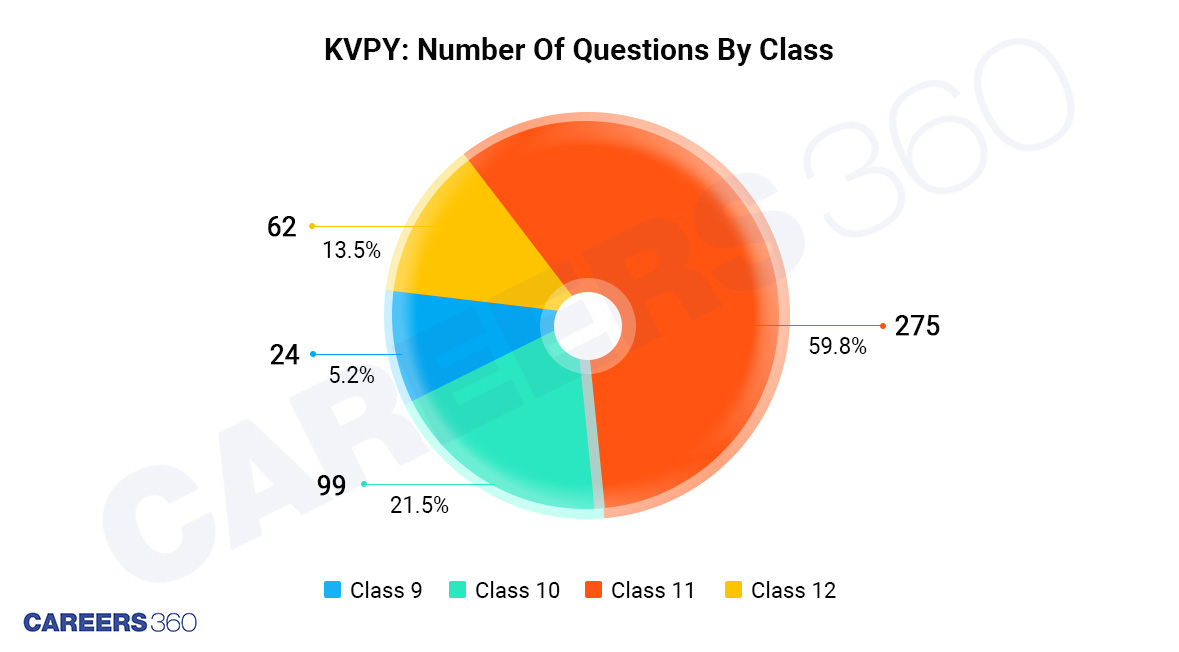 KVPY SA distribution of questions by class
KVPY SA distribution of questions by class
This implies that students in Class 11 have to study the Class 12 syllabus as well in order to get good marks. But focussing more on Class 11 will yield a better result. Now, let's have a look at the subject-wise, Class-wise weightage as well for better understanding and clarity on how to prepare.
KVPY SA Syllabus: Subject-Wise Analysis
As mentioned above, students are tested in four subjects for KVPY SA. An analysis of the weightage assigned to each chapter follows.Physics
The table below shows the number of questions from each Class in the Physics section of five years of KVPY question papers.
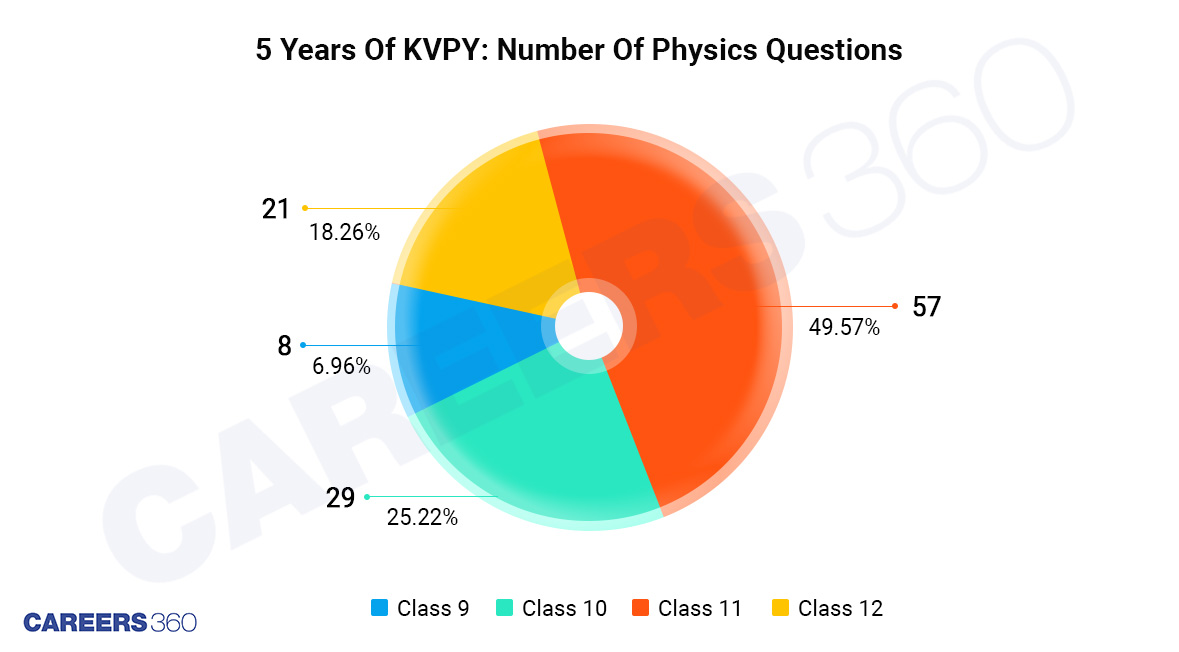 KVPY SA: Distribution of Physics questions by class
KVPY SA: Distribution of Physics questions by class
Almost half the questions in KVPY came from the Class 11 Physics syllabus. A quarter of the questions were asked from Class 10. Interestingly 18.26% questions were from Class 12 which means the Class 12 physics syllabus also demands significant attention.
Light- Reflection and Refraction (Class 10), Thermal Properties of Matter (Class 11), System of Particles and Rotational Motion (Class 11), Mechanical Properties of Fluids (Class 11) and Units and Measurement (Class 11) are some of the important topics that students should study more thoroughly because they have had higher weightage over the past few years.
The following chart shows how many questions came from each chapter.
KVPY Physics Syllabus: Chapter Questions Over 5 Years
Chapter Name | Class | No. of Questions |
Light- Reflection and Refraction | 10 | 22 |
Thermal Properties of Matter | 11 | 10 |
System of Particles and Rotational motion | 11 | 8 |
Mechanical Properties of Fluids | 11 | 7 |
Units and Measurement | 11 | 6 |
Electric Charges and Fields | 12 | 5 |
Electricity | 10 | 5 |
Gravitation | 11 | 5 |
Motion in a Straight Line | 11 | 5 |
Ray Optics and Optical Instruments | 12 | 5 |
Motion | 9 | 4 |
Motion in a Plane | 11 | 4 |
Current Electricity | 12 | 3 |
Work and Energy | 9 | 3 |
Work, Energy and Power | 11 | 3 |
Atoms | 12 | 2 |
Kinetic Theory | 11 | 2 |
Laws of Motion | 11 | 2 |
Mechanical Properties of Solids | 11 | 2 |
Nuclei | 12 | 2 |
Alternating Current | 12 | 1 |
Atoms and Molecules | 9 | 1 |
Dual Nature of Radiation and Matter | 12 | 1 |
Magnetic Effects of Electric Current | 10 | 1 |
Magnetism and Matter | 12 | 1 |
Moving charges and magnetism | 12 | 1 |
Oscillations | 11 | 1 |
Our Environment | 10 | 1 |
Thermodynamics | 11 | 1 |
Waves | 11 | 1 |
Chemistry
The table below shows the number of questions from each Class’ Chemistry syllabus asked over the past five years taken together. Clearly in the case of Chemistry, Class 10 and Class 12 have about equal weightage but there was no representation at all of the Class 9 syllabus.
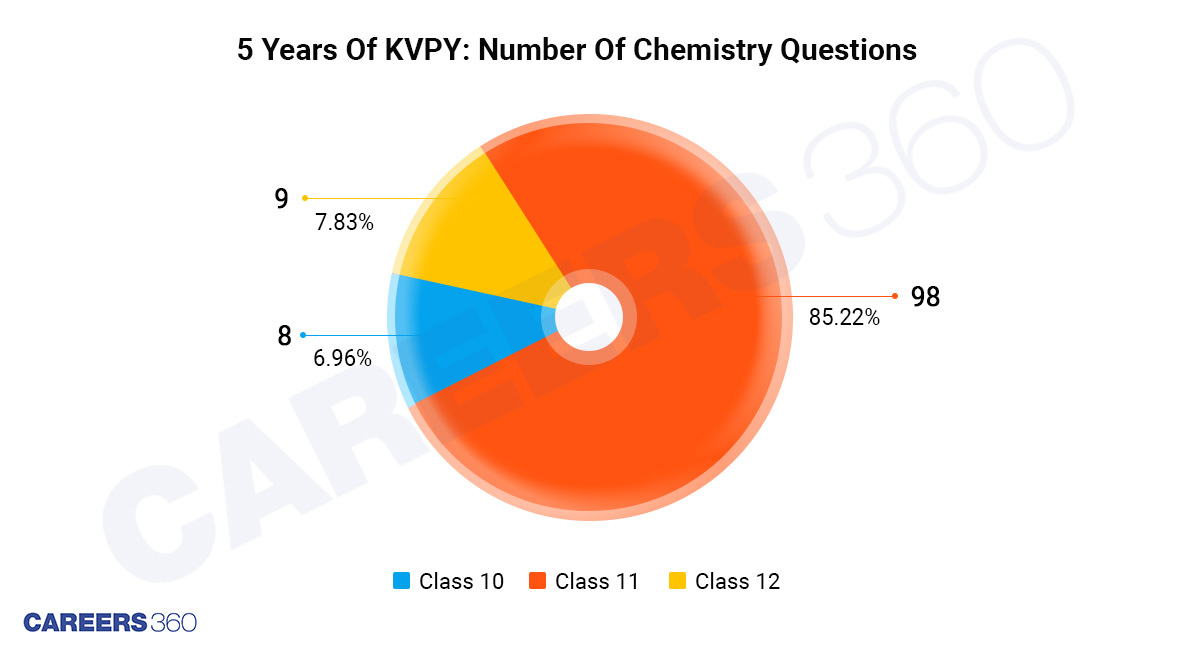
In the case of Chemistry, 85.22 % of questions were from Class 11 Chemistry syllabus.
Organic Chemistry- Some Basic Principles and Techniques (Class 11), Structure of Atom (Class 11), Hydrocarbons (Class 11), Some Basic Concepts of Chemistry (Class 11), Chemical Bonding and Molecular Structure (Class 11), Periodic Classification of Elements (Class 10), Redox Reaction (Class 11), States of Matter: Gases and Liquids (Class 11), and Thermodynamics (Class 11) are some of the more important topics.
Given below is a more detailed analysis of where the questions came from.
KVPY Chemistry Syllabus: Chapter Questions Over 5 Years
Chapter Name | Class | No. of Questions |
Organic Chemistry- Some Basic Principles and Techniques | 11 | 18 |
Structure of Atom | 11 | 14 |
Hydrocarbons | 11 | 13 |
Some Basic concepts of Chemistry | 11 | 12 |
Chemical Bonding and Molecular Structure | 11 | 7 |
Periodic Classification of elements | 10 | 6 |
Redox Reaction | 11 | 6 |
States of Matter : Gases and liquids | 11 | 6 |
Thermodynamics | 11 | 6 |
The P-Block Elements | 11 | 5 |
Equilibrium | 11 | 4 |
The S-Block Elements | 11 | 3 |
Amines | 12 | 2 |
General Principles and Processes of isolation of elements | 12 | 2 |
Hydrogen | 11 | 2 |
Aldehydes, Ketones and Carboxylic Acids | 12 | 1 |
Carbon and Its Compounds | 10 | 1 |
Chemical Kinetics | 12 | 1 |
Chemical Reactions and Equations | 10 | 1 |
Classification of Elements and Periodicity in Properties | 11 | 1 |
Electrochemistry | 12 | 1 |
Haloalkanes and Haloarenes | 12 | 1 |
Some p-Block Elements | 11 | 1 |
States of Matter | 11 | 1 |
Maths
As the chart below shows, in the case of Maths, Class 9 and Class 12 syllabi have roughly the same weightage.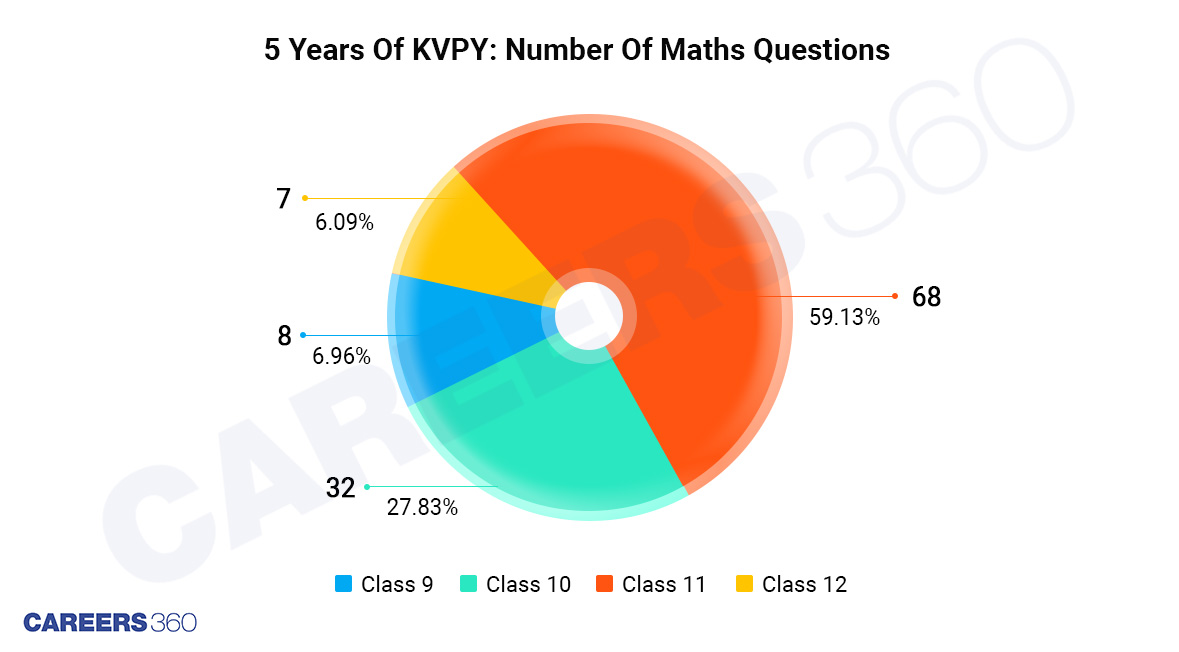
In the case of Maths, focussing on Class 10 and Class 11 syllabi only will be very effective for students as in past years, 87% of the questions were from them.
Sequences and Series (Class 11), Complex Numbers and Quadratic Equations (Class 11), Binomial Theorem (Class 11), Conic Sections (Class 11), Coordinate Geometry (Class 10), Permutations and Combinations (Class 11), Straight lines (Class 11), and Triangles (Class 10) are important topics for the KVPY exam.
The table below shows how many questions came from each topic of Mathematics over the past five years.
KVPY Maths Syllabus: Chapter Questions Over 5 YearsChapter Name | Class | No. of Questions |
Sequences and Series | 11 | 12 |
Complex Numbers and Quadratic Equations | 11 | 11 |
Binomial Theorem | 11 | 9 |
Conic Sections | 11 | 9 |
Coordinate Geometry | 10 | 7 |
Permutations and Combinations | 11 | 7 |
Straight lines | 11 | 6 |
Triangles | 10 | 6 |
Circles | 10 | 5 |
Polynomials | 10 | 5 |
Relations and Functions | 12 | 5 |
Real numbers | 10 | 4 |
Linear Inequalities | 11 | 3 |
Surface Area and Volumes | 9 | 3 |
Trigonometric Functions | 11 | 3 |
Areas of Parallelograms and Triangles | 9 | 2 |
Introduction To Euclid's Geometry | 9 | 2 |
Limits and Derivatives | 11 | 2 |
Probability | 12 | 2 |
Real Number | 10 | 2 |
Arithmetic Progressions | 10 | 1 |
Conic Section | 11 | 1 |
Quadratic Equations | 10 | 1 |
Quadrilaterals | 9 | 1 |
Relations and Functions | 11 | 1 |
Sequence and Series | 11 | 1 |
Sets | 11 | 1 |
Statistics | 11 | 1 |
Statistics | 11 | 1 |
Triangles | 10 | 1 |
Biology
Biology has the highest representation of questions from the Class 12 syllabus. As many as 25 have been asked over the past five years.
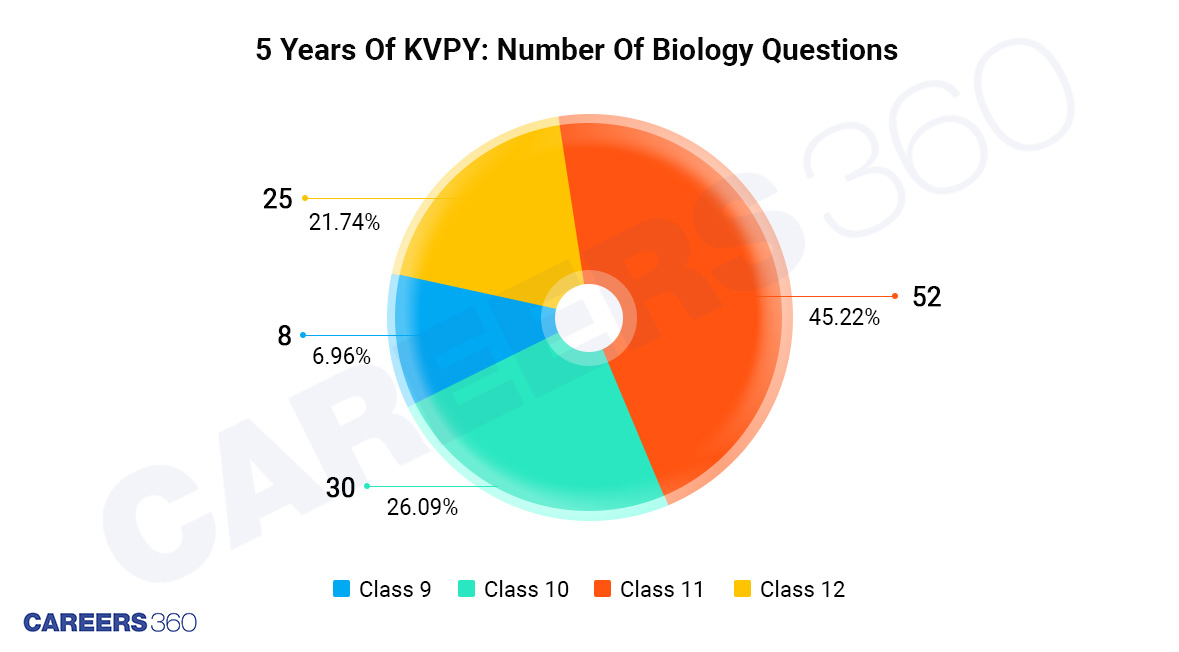
In Biology, 45% of questions were from Class 11 and nearly an equal number were asked from Classes 10 and 12, hence equal attention is advised for both.
Heredity and Evolution (Class 10), Life Processes (Class 10), Biomolecules (Class 11), Cell: The Unit of Life (Class 11), Principles of Inheritance and Variation (Class 12) and Body Fluids and Circulation (Class 11) are some of the more important topics, as the table below shows.
KVPY Biology Syllabus: Chapter Questions Over 5 Years
Chapter Name | Class | No. of Questions |
Heredity and Evolution | 10 | 9 |
Life Processes | 10 | 8 |
Biomolecules | 11 | 7 |
Cell: The Unit of Life | 11 | 7 |
Principles of Inheritance and Variation | 12 | 6 |
Body Fluids and Circulation | 11 | 5 |
Breathing and Exchange of Gases | 11 | 5 |
Cell Cycle and Cell Division | 11 | 5 |
Diversity in Living Organisms | 9 | 5 |
Human Health and Disease | 12 | 5 |
Molecular basis of inheritance | 12 | 5 |
How do organisms reproduce | 10 | 4 |
Our Environment | 10 | 4 |
Respiration in Plants | 11 | 4 |
Transport in Plants | 11 | 4 |
Control and Coordination | 10 | 3 |
Digestion and Absorption | 11 | 3 |
Evolution | 12 | 3 |
Excretory Products and their Elimination | 11 | 3 |
Anatomy of Flowering Plants | 11 | 2 |
Biotechnology : Principles and Processes | 12 | 2 |
Chemical Coordination and Integration | 11 | 2 |
Morphology of Flowering Plants | 11 | 2 |
The Human Eye and the colorful world | 10 | 2 |
Animal Kingdom | 11 | 1 |
Ecosystem | 12 | 1 |
Microbes in Human Welfare | 12 | 1 |
Natural Resources | 9 | 1 |
Neural Control and Coordination | 11 | 1 |
Organisms and Population | 12 | 1 |
Photosynthesis in Higher Plants | 11 | 1 |
Strategies for enhancement in food production | 12 | 1 |
The Fundamental unit of Life | 9 | 1 |
Why do we fall ill? | 9 | 1 |
KVPY Exam: How To Make It
Here are a few handy tips on how to approach your KVPY exam preparation and do well:
Start your preparation as early as possible. Ideally, you should start from just after the Class 10 board exams. One should target completing the Classes 9 and 10 syllabi in the time available just after the Class 10 board exams and before Class 11 begins. Revise all the important topics in-depth and practice questions. Starting early will also save you some time for revision during the last days
Cover the important topics from the Class 12 syllabus while studying for Class 11
Keep at least a month for revising the Class 9 and Class 10 parts of the syllabus
Attempt KVPY mock-tests online and improve your performance and strategy
Focus especially on mastering topics with higher weightage
Make a strategy or study plan but include breaks in that as well
Solve all the KVPY previous year's question papers
Keep negative marking in mind — don’t attempt questions if you are not sure of the answer
On the day of the paper, keep calm, stop revision one day before the exam and refresh yourself
Eat healthy and have a good amount of sleep.
Study your school and the KVPY syllabi together. Go through important topics regularly, practice questions and diagrams diligently. It also helps to keep yourself updated with recent scientific research.
Applications for Admissions are open.
As per latest syllabus. Physics formulas, equations, & laws of class 11 & 12th chapters
JEE Main Important Chemistry formulas
Get nowAs per latest syllabus. Chemistry formulas, equations, & laws of class 11 & 12th chapters
JEE Main high scoring chapters and topics
Get nowAs per latest 2024 syllabus. Study 40% syllabus and score upto 100% marks in JEE
JEE Main Important Mathematics Formulas
Get nowAs per latest syllabus. Maths formulas, equations, & theorems of class 11 & 12th chapters
